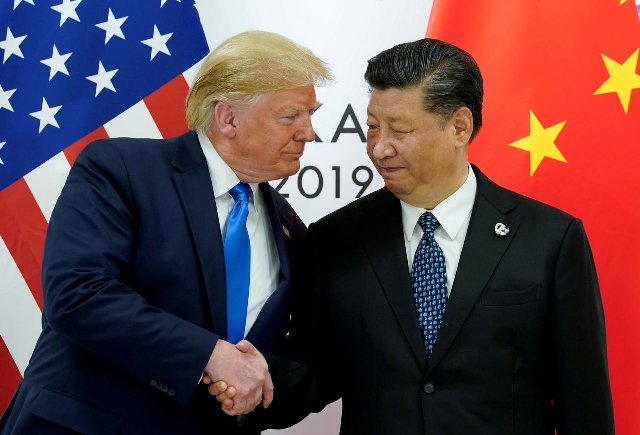The next economic super power
Beijing is taking unique initiatives to connect world through infrastructure projects

As the world has moved into the third decade of 21st century, the power centres controlling the global economy are changing and China is currently on its way to become the next economic super power of the world.
Many global experts believe China has already crossed some key indicators and it is just a matter of a few years when the country secures the top slot in world economic rankings.
Today, China is best known as the “world’s factory” due to its business ecosystem, low taxes and duties, competitive currency and a huge manufacturing and export base.
The United States is feeling the heat as China excels in nearly every sector of the economy and life. This apprehension may have compelled the Trump administration to slap 25% tariffs on Chinese goods imports of around $360 billion, triggering a trade war between the two biggest economies of the world.
The tariff hike was followed by a ban on some Chinese technology and communication companies like Huawei and ZTE Corporation by US President Donald Trump in 2019, citing national security concerns. The practice of placing restrictions on more Chinese companies is still going on with the latest examples being TikTok and WeChat.
Since in the modern world the strength of an economy determines where the country stands globally, China is moving forward at a rapid pace, thanks to its huge population base which is estimated at around 1.4 billion people.
This huge population is the biggest attraction for global companies to sell their products. For years, many American as well as European companies have invested in the Chinese economy.
Such investments have given these companies a double edge as they cater to the needs of Chinese people in different sectors as well as serve as an export hub for other Asian, Middle Eastern and North African countries.
Apart from foreign investment, China’s own manufacturing base has expanded rapidly and the country is now ranked first in industrial output.
Its major industries include iron and steel, aluminium, coal, machinery, armaments, textile and apparel, petroleum, cement, chemical, fertiliser, food processing, automobile and other transportation sources including railcars and locomotives, ships and aircraft, consumer products including footwear, toys and electronics, telecommunication and information technology, and many more.
The country is paying special attention to information technology with special focus on artificial intelligence, robotics, etc.
It is leading the race in telecommunication, smartphone manufacturing and allied industries and is becoming a source of hardware and technology provider to many economies of the world. It is also racing ahead to launch the fifth generation (5G) technology.
All such developments have put China in a position where it can easily lead the world in terms of technological advancement, industrial, services and the overall economic base while keeping its own population engaged in different sectors of the economy as well as expanding the size of its economy.
According to the World Bank, China’s gross domestic product (GDP) in purchasing power parity (PPP) terms surpassed that of the US in 2013. In 2019, China’s GDP in PPP terms stood at $23.46 trillion, making it the largest economy in the world and accounting for nearly 19% of the global economy.
For 2020, the International Monetary Fund (IMF) has estimated that China’s GDP in PPP terms will be around $27.80 trillion, much more than the US GDP of $20.29 trillion. However, the Covid-19 pandemic may have an impact on these estimates.
In nominal terms, China’s GDP in 2019 stood at $14.14 trillion against $13.37 trillion in 2018. The country recorded GDP growth of 6.6% in 2018 and 6.1% in 2019.
The size of China’s nominal GDP in 2018 was lower than the US GDP by $7.21 trillion but the gap is shrinking rapidly.
Earlier, the IMF predicted a real GDP growth of 5.8% for China but in June 2020 it revised the growth estimate downward to 1% due to Covid-19.
Still, the forecast growth rate is better than that for other major economies like the US and EU, which are expected to contract by 8% and 10.2% respectively.
All such developments have increased the importance of China as it is becoming impossible for the world to ignore it.
Any economic depression in China could lead to a greater depression in world markets. In this regard, the most recent example is the closure of Chinese economy in early 2020 due to Covid-19, which immediately impacted many Asian and European countries since their markets were relying more on the import of raw material and products from China.
Beijing is also taking some unique initiatives to connect the world through infrastructure development projects. Its flagship Belt and Road Initiative (BRI) will connect China with the rest of the world, making trade much easier through all means of transportation.
BRI is a huge initiative that will connect around 65 countries, 4.4 billion people and 40% of the global GDP.
The project is receiving appreciation in many countries since China is investing billions of dollars in different economies. However, some countries are criticising the initiative as they fear they will lose their influence on the world economy.
Only time will tell who is on the right path. China’s policy is not to confront its opponents militarily but it is battling to beat them in economic advancement. The country has moved much faster to economic greatness and is likely to become the top global economic power with the same approach.
The writer is a staff correspondent



















COMMENTS
Comments are moderated and generally will be posted if they are on-topic and not abusive.
For more information, please see our Comments FAQ